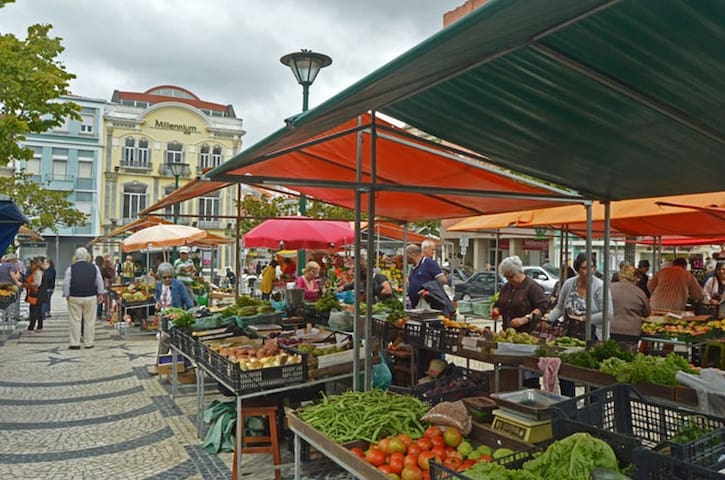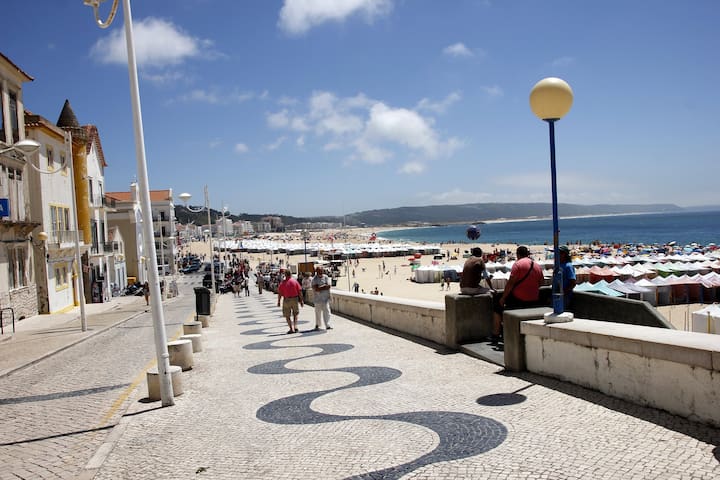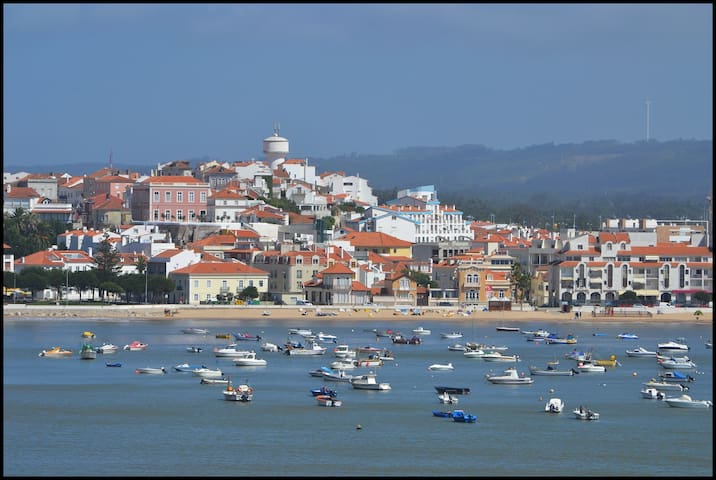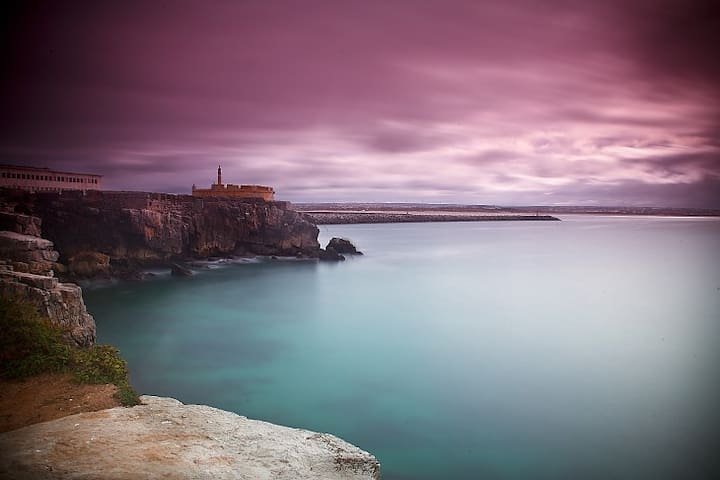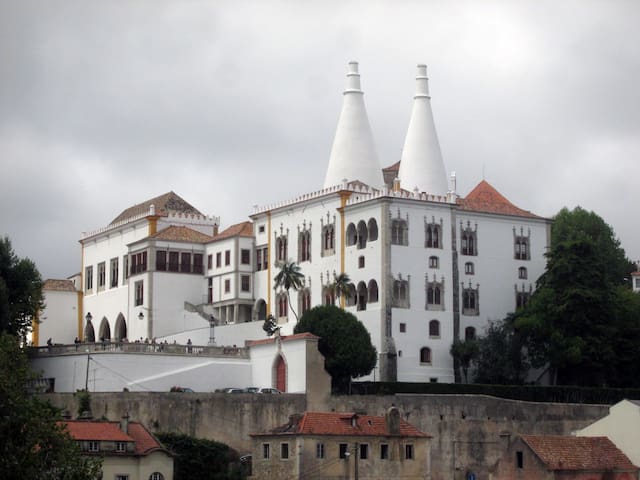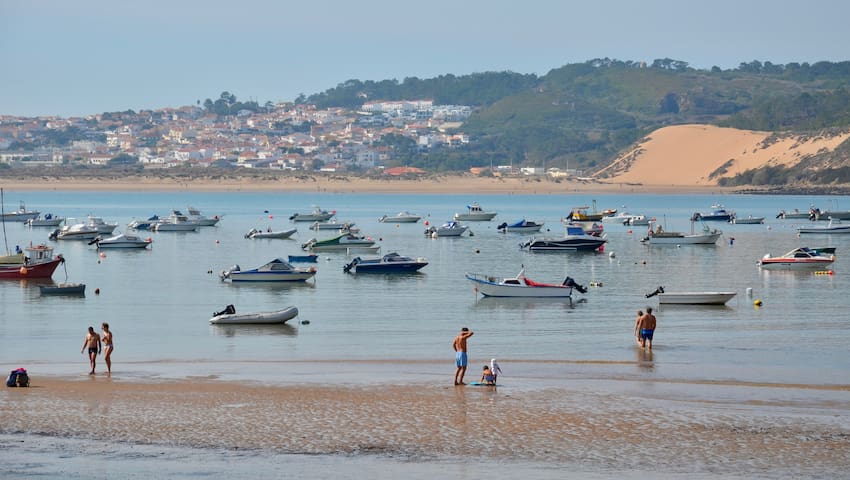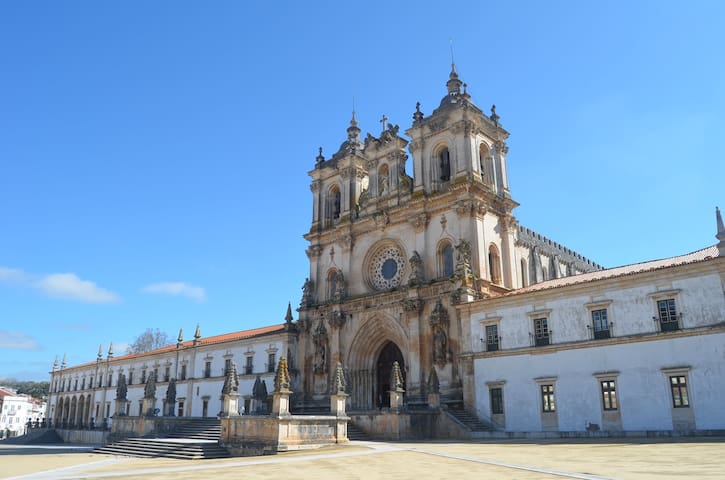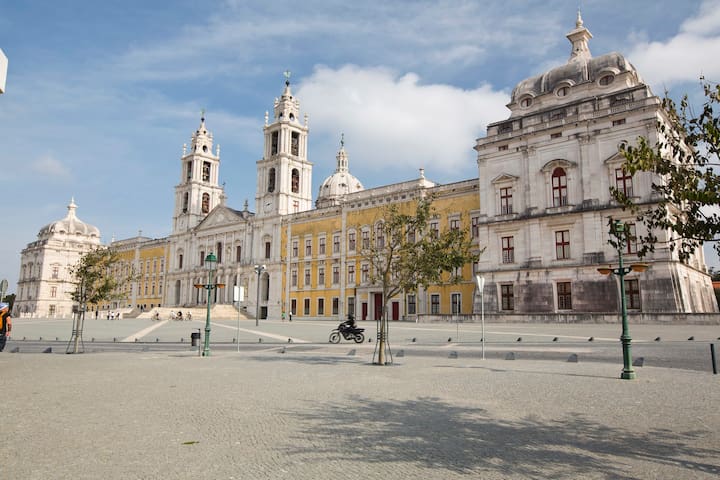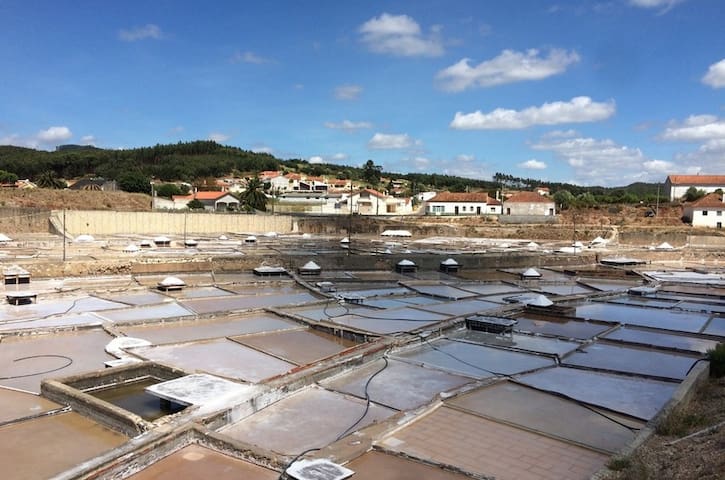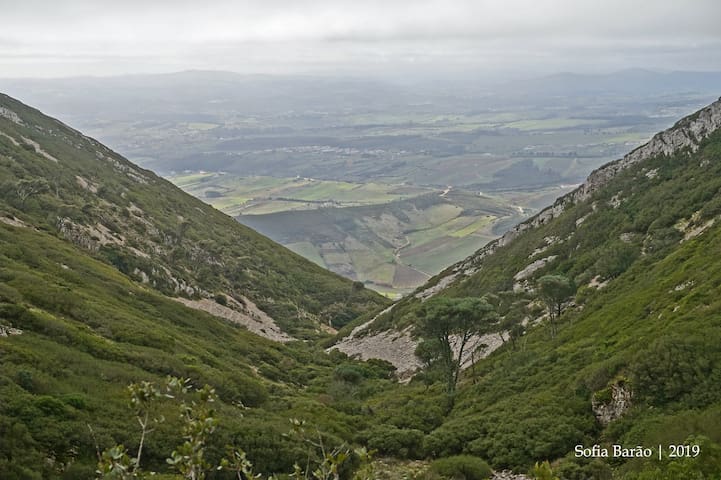City/town information
Caldas owes its name to the thermal spring which was much appreciated by Queen (rainha) D. Leonor, wife of D. João II, king of Portugal in the 15th century. The town continued to grow and peaked at the end of the 19th and beginning of the 20th century in which it was fashionable to stay in a spa: it was one of the places where the nobility and the aristocrats allowed themselves to be treated. There is little left of this today although they have started to upgrade the spa again. The
romantic and marvelous romantic park created along with the spa is still very much worth a visit, certainly on a hot day.
Meanwhile it has grown into a solid provincial town where you will find all the facilities, including plenty of supermarkets. Discover the city via one of its elaborated walking routes. One of them is called the Rota Bordalliana, to the famous ceramic bakers family Bordallo Pinheiro. They designed and baked beautiful "azuleijos" with which many houses in Caldas have been and still are lined. Nevertheless their most important activity are traditional household ceramics. In addition, they also designed large and smaller ceramic sculptures now scattered across the city. More information about the walking route via http://www.centerofportugal.com/the-routes-of-bordallo-pinheiro
In the city park you will still find the shop of Bordallo Pinheiro where you can discover and buy their typical ceramics.
180 personas locales recomiendan
Caldas da Rainha
Caldas owes its name to the thermal spring which was much appreciated by Queen (rainha) D. Leonor, wife of D. João II, king of Portugal in the 15th century. The town continued to grow and peaked at the end of the 19th and beginning of the 20th century in which it was fashionable to stay in a spa: it was one of the places where the nobility and the aristocrats allowed themselves to be treated. There is little left of this today although they have started to upgrade the spa again. The
romantic and marvelous romantic park created along with the spa is still very much worth a visit, certainly on a hot day.
Meanwhile it has grown into a solid provincial town where you will find all the facilities, including plenty of supermarkets. Discover the city via one of its elaborated walking routes. One of them is called the Rota Bordalliana, to the famous ceramic bakers family Bordallo Pinheiro. They designed and baked beautiful "azuleijos" with which many houses in Caldas have been and still are lined. Nevertheless their most important activity are traditional household ceramics. In addition, they also designed large and smaller ceramic sculptures now scattered across the city. More information about the walking route via http://www.centerofportugal.com/the-routes-of-bordallo-pinheiro
In the city park you will still find the shop of Bordallo Pinheiro where you can discover and buy their typical ceramics.
Nazaré is an authentic fishermen’s village, about 15 km north, on a beautiful beach, in a bay surrounded by high rocks. Fishermen and fisherwomen in traditional attire are still strolling around here while repairing nets and drying fish on beach racks. The brightly coloured boats with their high bow, once pulled out of the sea by oxen, are still in use today. The typical beach tents in many colours offer shade to the beachgoer.
High above the city lies Sitio, which can be reached by cable car.
From Nazaré you can also do many excursions and activities at sea. Quad trips in the area are also organised from here. You can get more information and register at the stalls and booths of the various providers on the dike of Nazaré.
If you drive to Nazaré, go via the Rua Vasco da Gama to the Rua Bartolomeu Dias. It will give you unforgettable views over the ocean and the cliffs. In the village of Serra da Pescaria turn left and drive down to the beautiful and quiet Praia do Salgado. You can eat or drink something in the bar-restaurant Anzol situated right at the beach. Also the sunsets with clear weather are beautiful here.
411 personas locales recomiendan
Nazaré
20 R. do HorizonteNazaré is an authentic fishermen’s village, about 15 km north, on a beautiful beach, in a bay surrounded by high rocks. Fishermen and fisherwomen in traditional attire are still strolling around here while repairing nets and drying fish on beach racks. The brightly coloured boats with their high bow, once pulled out of the sea by oxen, are still in use today. The typical beach tents in many colours offer shade to the beachgoer.
High above the city lies Sitio, which can be reached by cable car.
From Nazaré you can also do many excursions and activities at sea. Quad trips in the area are also organised from here. You can get more information and register at the stalls and booths of the various providers on the dike of Nazaré.
If you drive to Nazaré, go via the Rua Vasco da Gama to the Rua Bartolomeu Dias. It will give you unforgettable views over the ocean and the cliffs. In the village of Serra da Pescaria turn left and drive down to the beautiful and quiet Praia do Salgado. You can eat or drink something in the bar-restaurant Anzol situated right at the beach. Also the sunsets with clear weather are beautiful here.
Located on the other side of the bay, has a sandy beach at a bay almost completely sealed off from the ocean. It is loved by families with children. In the centre there are many shops, restaurants and pubs. A supermarket can be found on the outskirts of the village.
You can take a marked walk that will take you to the cliffs in the direction of Nazaré. You can deviate from the path and descend to the vast and peaceful Praia da Gralha. Also a sunset during the evening hours here is wonderful.
188 personas locales recomiendan
São Martinho do Porto
Located on the other side of the bay, has a sandy beach at a bay almost completely sealed off from the ocean. It is loved by families with children. In the centre there are many shops, restaurants and pubs. A supermarket can be found on the outskirts of the village.
You can take a marked walk that will take you to the cliffs in the direction of Nazaré. You can deviate from the path and descend to the vast and peaceful Praia da Gralha. Also a sunset during the evening hours here is wonderful.
Where the Atlantic Ocean flows into the Laguna de Óbidos lays the village of Foz do Arelho, popular bathing and beach resort. Here you can choose from two different types of beaches on the same spot. On the one hand there is the lagoon, a beautiful location whose banks are deeper inland lushly vegetated. The water is calm and ideal for children and for windsurfing, the latter favoured by an ideal wind blowing from the ocean. On the other hand, there is the beach by the ocean. The ocean
has waves but no major currents. It offers excellent conditions for (kite)surfing and carries the blue flag, which testifies the excellent quality of the water.
If you come by car from Salir do Porto via the Estrade Atlântica to Foz, we recommend you to park your car in the car park at the first roundabout just outside Foz. From there, take the decking path to Foz and you'll get spectacular views of the lagoon and ocean. On Avenida do Mar, at the very bottom
of the lagoon's inlet, there are a whole range of bars and restaurants from where you can also enjoy this beautiful natural phenomenon with a snack, meal or drink.
148 personas locales recomiendan
Foz do Arelho
Where the Atlantic Ocean flows into the Laguna de Óbidos lays the village of Foz do Arelho, popular bathing and beach resort. Here you can choose from two different types of beaches on the same spot. On the one hand there is the lagoon, a beautiful location whose banks are deeper inland lushly vegetated. The water is calm and ideal for children and for windsurfing, the latter favoured by an ideal wind blowing from the ocean. On the other hand, there is the beach by the ocean. The ocean
has waves but no major currents. It offers excellent conditions for (kite)surfing and carries the blue flag, which testifies the excellent quality of the water.
If you come by car from Salir do Porto via the Estrade Atlântica to Foz, we recommend you to park your car in the car park at the first roundabout just outside Foz. From there, take the decking path to Foz and you'll get spectacular views of the lagoon and ocean. On Avenida do Mar, at the very bottom
of the lagoon's inlet, there are a whole range of bars and restaurants from where you can also enjoy this beautiful natural phenomenon with a snack, meal or drink.
Peniche is one of the largest fishing ports in Portugal and also an important water sports centre on the Atlantic Ocean. There is a small historical centre including the Fortaleza de Peniche, which was used as a prison for political prisoners under the last dictatorship. Inside the fortress is the Museo Municipal where you can find out more about this. Furthermore, the town is known for the lace that was made by fisherwomen while their husbands were at sea.
The beaches of Peniche are also an important attraction. The bays of Consolação and Baleal offer protection to the ocean and wind and are ideal for families. Praia de Medão Grande is considered one of the best beaches for surfers and bodyboarders and is also called “Supertubos” due to its ideal
tubular waves.
On a boat trip away (12 km, +/- 45' sailing) is the protected nature reserve of Ilha das Berlengas. Berlenga Grande (only 1,500 by 800 metres) is the largest island of the group and the only inhabitable one. The island of Berlenga has a bay with ice-cold, crystal-clear water, a small harbour and a sheltered beach. There is also the São João Baptista stone fortress, built on the ruins of a monastery. Explore the island on a walk to the fortress or the lighthouse (both with climbing and stairs). Or get in a boat for a trip around the island, a great way to visit the island's beautiful caves. The crossing to Berlenga can be booked in the port of Peniche. There are regular boat services (April-October), but smaller fishing boats also offer the trip. To avoid tourist crowds, a maximum of 350 people are allowed to cross each day. There is no sailing in bad weather. Practical info:
https://www.cm-peniche.pt/visitar/ilha-da- berlenga-reserva-mundial-da-bioesfera-da-unesco
110 personas locales recomiendan
Peniche, Portugal
Peniche is one of the largest fishing ports in Portugal and also an important water sports centre on the Atlantic Ocean. There is a small historical centre including the Fortaleza de Peniche, which was used as a prison for political prisoners under the last dictatorship. Inside the fortress is the Museo Municipal where you can find out more about this. Furthermore, the town is known for the lace that was made by fisherwomen while their husbands were at sea.
The beaches of Peniche are also an important attraction. The bays of Consolação and Baleal offer protection to the ocean and wind and are ideal for families. Praia de Medão Grande is considered one of the best beaches for surfers and bodyboarders and is also called “Supertubos” due to its ideal
tubular waves.
On a boat trip away (12 km, +/- 45' sailing) is the protected nature reserve of Ilha das Berlengas. Berlenga Grande (only 1,500 by 800 metres) is the largest island of the group and the only inhabitable one. The island of Berlenga has a bay with ice-cold, crystal-clear water, a small harbour and a sheltered beach. There is also the São João Baptista stone fortress, built on the ruins of a monastery. Explore the island on a walk to the fortress or the lighthouse (both with climbing and stairs). Or get in a boat for a trip around the island, a great way to visit the island's beautiful caves. The crossing to Berlenga can be booked in the port of Peniche. There are regular boat services (April-October), but smaller fishing boats also offer the trip. To avoid tourist crowds, a maximum of 350 people are allowed to cross each day. There is no sailing in bad weather. Practical info:
https://www.cm-peniche.pt/visitar/ilha-da- berlenga-reserva-mundial-da-bioesfera-da-unesco
Óbidos is without any doubt one of Portugal's most beautiful walled medieval settlements and has been declared National Momument. The white houses are within the 14th century walls. The village is car-free and you can stroll quietly through the cobbled streets. The 13 metres high city wall of is completely accessible to the public. An entire circular walk is 1.6 kilometres. From here you have a beautiful view over the town and the surrounding area. There is no barrier, so be careful.
You will also find numerous suppliers of Ginjinha or Ginha de Óbidos, a liqueur made from a wild sour but tasty cherry from the region. You can taste the liqueur from a small chocolate cup that you can of course eat along with it. If you like it you can buy the liqueur that is offered in bottles.
During a few weeks of the summer months Óbidos will put on a medieval dress. Then there is the annual festival Mercado Medieval de Óbidos. Hundreds of actors wear medieval costumes. You will find beggars, falconers, noblemen, soothsayers, musicians... and jesters .Furthermore there are
medieval games (also on horseback), a medieval market where you can eat medieval food from the spit. Look for current dates on the website of Mercado Medieval de Óbidos.
Chocolate addicts should of course not miss the annual chocolate festival in Óbidos. In spring (April-May) the town is dominated by chocolate for days on end. At the stalls you can taste and buy chocolate in all possible varieties. There are cooking courses with chocolate, show cooking, chocolate
sculptures and special activities for children. For current dates, please visit the Chocolate Festival website: www.festivalchocolate.cm-obidos.pt.
583 personas locales recomiendan
Óbidos Municipality
Óbidos is without any doubt one of Portugal's most beautiful walled medieval settlements and has been declared National Momument. The white houses are within the 14th century walls. The village is car-free and you can stroll quietly through the cobbled streets. The 13 metres high city wall of is completely accessible to the public. An entire circular walk is 1.6 kilometres. From here you have a beautiful view over the town and the surrounding area. There is no barrier, so be careful.
You will also find numerous suppliers of Ginjinha or Ginha de Óbidos, a liqueur made from a wild sour but tasty cherry from the region. You can taste the liqueur from a small chocolate cup that you can of course eat along with it. If you like it you can buy the liqueur that is offered in bottles.
During a few weeks of the summer months Óbidos will put on a medieval dress. Then there is the annual festival Mercado Medieval de Óbidos. Hundreds of actors wear medieval costumes. You will find beggars, falconers, noblemen, soothsayers, musicians... and jesters .Furthermore there are
medieval games (also on horseback), a medieval market where you can eat medieval food from the spit. Look for current dates on the website of Mercado Medieval de Óbidos.
Chocolate addicts should of course not miss the annual chocolate festival in Óbidos. In spring (April-May) the town is dominated by chocolate for days on end. At the stalls you can taste and buy chocolate in all possible varieties. There are cooking courses with chocolate, show cooking, chocolate
sculptures and special activities for children. For current dates, please visit the Chocolate Festival website: www.festivalchocolate.cm-obidos.pt.
Santarém is a small, modern European town with a population of around 63 thousand inhabitants. It is the capital of the province of Ribatejo. The city is well known for its bull fighting arena where only the best bullfighters are allowed to enter the forum. The centre is formed by the Largo Sá da Bandeira which also houses the main church. Along this square runs the central Rua Serpa Pinto. One of Portugal's heroes is buried in the Gothic Igreja da Graça church, the discoverer of Brazil (1500),
Pedro Alvares Cabral.
35 personas locales recomiendan
Santarem
Santarém is a small, modern European town with a population of around 63 thousand inhabitants. It is the capital of the province of Ribatejo. The city is well known for its bull fighting arena where only the best bullfighters are allowed to enter the forum. The centre is formed by the Largo Sá da Bandeira which also houses the main church. Along this square runs the central Rua Serpa Pinto. One of Portugal's heroes is buried in the Gothic Igreja da Graça church, the discoverer of Brazil (1500),
Pedro Alvares Cabral.
The villa is well situated to do a daytrip to Lisbon, Portugal's well known capital. It takes approximately 1 hour for the trip. You can go there:
By car: drive to and park at Colombo Shopping Center - Avenida Lusíada, 1500 – 392 Lisboa, take the metro at the Colégio Militar/Luz stop towards the centre (Baixa-Chiado stop).
By express bus from Caldas da Rainha: the buses depart from the bus station located on the Rua do Dr. Leão Azedo in the centre of Caldas. It is best to park your car in the parking under the Centro Cultural e Congresso (CCC) in Caldas which you can reach by taking the N8 to Caldas. It is within walking distance of the bus station (if you come out of the car park cross the street and go straight ahead, between the second and third side street on the left is the bus station). You take a bus from the Rodoviária do Oeste. Information on departure and arrival times and fares can be found at http://rodoviariadooeste.pt/horarios-e-precos.
You can buy tickets online or at the ticket offices in the bus station. The bus stops in Lisbon at the Campo Grande. There you can take the metro to the centre (station Rossio).
By express bus from Sáo Martinho do Porto: this service is provided by the Rede Expressos buses. The bus stop is directly opposite the InterMarché supermarket (bus stop closest to the school).
Tickets must be purchased in advance at the post office or via the Rede Expressos website.
https://www.rede-expressos.pt/tickets.
Buses stop in Lisbon at the Zoo (Sete Rios) from where you
can take the metro to the city centre.
534 personas locales recomiendan
Lisbon
The villa is well situated to do a daytrip to Lisbon, Portugal's well known capital. It takes approximately 1 hour for the trip. You can go there:
By car: drive to and park at Colombo Shopping Center - Avenida Lusíada, 1500 – 392 Lisboa, take the metro at the Colégio Militar/Luz stop towards the centre (Baixa-Chiado stop).
By express bus from Caldas da Rainha: the buses depart from the bus station located on the Rua do Dr. Leão Azedo in the centre of Caldas. It is best to park your car in the parking under the Centro Cultural e Congresso (CCC) in Caldas which you can reach by taking the N8 to Caldas. It is within walking distance of the bus station (if you come out of the car park cross the street and go straight ahead, between the second and third side street on the left is the bus station). You take a bus from the Rodoviária do Oeste. Information on departure and arrival times and fares can be found at http://rodoviariadooeste.pt/horarios-e-precos.
You can buy tickets online or at the ticket offices in the bus station. The bus stops in Lisbon at the Campo Grande. There you can take the metro to the centre (station Rossio).
By express bus from Sáo Martinho do Porto: this service is provided by the Rede Expressos buses. The bus stop is directly opposite the InterMarché supermarket (bus stop closest to the school).
Tickets must be purchased in advance at the post office or via the Rede Expressos website.
https://www.rede-expressos.pt/tickets.
Buses stop in Lisbon at the Zoo (Sete Rios) from where you
can take the metro to the city centre.
At the estuary of the Tagus river is the Belém district, the district of the voyages of discovery, which is inextricably linked to the Portuguese Golden Age. You will find the Torre de Belém and the Mosteiro dos Jerónimos Monastery, two monuments recognised as World Heritage Sites. But the Museu dos
Coches (Coach Museum) and the modern Centro Cultural de Belém are also worth a visit. And don't forget to eat a delicious "pastel de Belém"! According to tradition, the one and only with the secret recipe!
217 personas locales recomiendan
Belém
At the estuary of the Tagus river is the Belém district, the district of the voyages of discovery, which is inextricably linked to the Portuguese Golden Age. You will find the Torre de Belém and the Mosteiro dos Jerónimos Monastery, two monuments recognised as World Heritage Sites. But the Museu dos
Coches (Coach Museum) and the modern Centro Cultural de Belém are also worth a visit. And don't forget to eat a delicious "pastel de Belém"! According to tradition, the one and only with the secret recipe!
This is a magical, mysterious place where man lives in such perfect harmony with nature that UNESCO has placed the town on the World Heritage List. On the square in the centre you will immediately discover the typical cone-shaped chimneys of the Palácio da Vila. This palace from the 14th century was the summer residence of many kings of Portugal. The Palácio and the Quinta da Regaleira are also worth a visit.
If you move into the hills you will find one of the most romantic
palaces of Portugal, the Palácio da Pena. It is an imaginative construction, in the romantic style of the 19th – century and born from the passion and imagination of the artistic king Ferdinand of Saxony Coburg-Gotha, husband of Queen D. Maria II.
1253 personas locales recomiendan
Sintra
This is a magical, mysterious place where man lives in such perfect harmony with nature that UNESCO has placed the town on the World Heritage List. On the square in the centre you will immediately discover the typical cone-shaped chimneys of the Palácio da Vila. This palace from the 14th century was the summer residence of many kings of Portugal. The Palácio and the Quinta da Regaleira are also worth a visit.
If you move into the hills you will find one of the most romantic
palaces of Portugal, the Palácio da Pena. It is an imaginative construction, in the romantic style of the 19th – century and born from the passion and imagination of the artistic king Ferdinand of Saxony Coburg-Gotha, husband of Queen D. Maria II.
However small the village may be, there are a few things to discover next to the beach, dunes and bay.
Just outside the village, on the north-west side, you will find the Miradouro, one of the highest points of the village, and from where you have a beautiful view of the valley that used to be a lagoon that reached as far as Alfeizerão.
From the beach you can see ruins on the other side of the river Rio Tornada. You can get there via a narrow but passable path through the dunes. These are the ruins of Alfândega. From here you have a magnificent view of the bay of São Martinho. A long time ago this was a customs building further surrounded by a construction and repair site of ships carpentered with wood from the Leiria region. It is assumed that boats built here took part in Vasco da Gama's voyages of discovery towards India
and Brazil.
Take the road up to the left just before the municipal swimming pool and keep to the right and you will arrive at the end of the cliff at the chapel of Sant'Ana. The chapel was built on this site to bless the boats built at the local shipyards and launched into the water. Here the view is also breathtaking and you can not only see the whole bay, but also have a wide view over the ocean.
Between the Sant'Ana Chapel and the customs ruins is a third place of interest: the 'Pocinhas' de Salir. It is a source of fresh water that rises directly from close to the sea. The water is drinkable and, according to analyses, it is rich in minerals that give it digestive and bathing properties. The name 'Pocinhas' de Salir owes its name to the puddles of fresh water that are formed in the rocks during low tide and in which it is possible to bathe. The origin of these sulphurous waters lies in the south-
western limestone that stretches up to the Serra do Bouro and from which the water rises upwards via a fissure.
10 personas locales recomiendan
Salir do Porto
However small the village may be, there are a few things to discover next to the beach, dunes and bay.
Just outside the village, on the north-west side, you will find the Miradouro, one of the highest points of the village, and from where you have a beautiful view of the valley that used to be a lagoon that reached as far as Alfeizerão.
From the beach you can see ruins on the other side of the river Rio Tornada. You can get there via a narrow but passable path through the dunes. These are the ruins of Alfândega. From here you have a magnificent view of the bay of São Martinho. A long time ago this was a customs building further surrounded by a construction and repair site of ships carpentered with wood from the Leiria region. It is assumed that boats built here took part in Vasco da Gama's voyages of discovery towards India
and Brazil.
Take the road up to the left just before the municipal swimming pool and keep to the right and you will arrive at the end of the cliff at the chapel of Sant'Ana. The chapel was built on this site to bless the boats built at the local shipyards and launched into the water. Here the view is also breathtaking and you can not only see the whole bay, but also have a wide view over the ocean.
Between the Sant'Ana Chapel and the customs ruins is a third place of interest: the 'Pocinhas' de Salir. It is a source of fresh water that rises directly from close to the sea. The water is drinkable and, according to analyses, it is rich in minerals that give it digestive and bathing properties. The name 'Pocinhas' de Salir owes its name to the puddles of fresh water that are formed in the rocks during low tide and in which it is possible to bathe. The origin of these sulphurous waters lies in the south-
western limestone that stretches up to the Serra do Bouro and from which the water rises upwards via a fissure.
Bezienswaardigheden
This small town lies in the valleys of the rivers Alcoa and Baça, which, according to some writers, gave Alcobaça its name. The city owes its fame and development to the monastery Santa Maria de Alcobaça, founded in 1153 by order of the Order of the Cistercians. However, construction did not
begin until 1178. Built on the model of the Abbey of Clairvaux, the mother house of the Order of Cistercians in France, the Mosteiro de Sant Maria de Alcobaça is a magnificent monument declared a UNESCO World Heritage Site. You can freely enter the church and visit the tombs of Peter I of
Portugal and of his mistress, and posthumous lawfully declared wife, Inês de Castro. The monastery itself is also worth a visit, subject to payment of entry fees. Especially the gigantic medieval kitchen is impressive.
For the lovers of sweets: opposite the abbey you will find Pastelaria Alcôa, truly the best pastelaria on the Silver Coast.
359 personas locales recomiendan
Alcobaça
This small town lies in the valleys of the rivers Alcoa and Baça, which, according to some writers, gave Alcobaça its name. The city owes its fame and development to the monastery Santa Maria de Alcobaça, founded in 1153 by order of the Order of the Cistercians. However, construction did not
begin until 1178. Built on the model of the Abbey of Clairvaux, the mother house of the Order of Cistercians in France, the Mosteiro de Sant Maria de Alcobaça is a magnificent monument declared a UNESCO World Heritage Site. You can freely enter the church and visit the tombs of Peter I of
Portugal and of his mistress, and posthumous lawfully declared wife, Inês de Castro. The monastery itself is also worth a visit, subject to payment of entry fees. Especially the gigantic medieval kitchen is impressive.
For the lovers of sweets: opposite the abbey you will find Pastelaria Alcôa, truly the best pastelaria on the Silver Coast.
The Fátima Sanctuary is one of the most important places of pilgrimage for worship of Mary where
pilgrims from all over the world come together. Thousands of candles illuminate the square during
the night mass.
220 personas locales recomiendan
Fátima
The Fátima Sanctuary is one of the most important places of pilgrimage for worship of Mary where
pilgrims from all over the world come together. Thousands of candles illuminate the square during
the night mass.
The order to build the monastery in 1386, to thank the Virgin Mary, came after the victory of the Portuguese over the Castillians in the battle of Aljubarrota. It became a Dominican monastery, the construction of which took about 200 years. It is one of the most beautiful late Gothic buildings with
Manueline influences of Portugal.
103 personas locales recomiendan
Batalha
The order to build the monastery in 1386, to thank the Virgin Mary, came after the victory of the Portuguese over the Castillians in the battle of Aljubarrota. It became a Dominican monastery, the construction of which took about 200 years. It is one of the most beautiful late Gothic buildings with
Manueline influences of Portugal.
Because of its splendour, the monumental architectural ensemble in Mafra (palace, monastery and basilica) testifies to the great wealth of the court of D. João V (1707-1750), the king who had it built, making it the most important Portuguese Baroque monument.
This visit can be combined on Thursdays with the weekly market in Malveira, a few kilometres east of Mafra. A very popular market that attracts people from all over the region.
250 personas locales recomiendan
Mafra National Palace
Terreiro Dom João VBecause of its splendour, the monumental architectural ensemble in Mafra (palace, monastery and basilica) testifies to the great wealth of the court of D. João V (1707-1750), the king who had it built, making it the most important Portuguese Baroque monument.
This visit can be combined on Thursdays with the weekly market in Malveira, a few kilometres east of Mafra. A very popular market that attracts people from all over the region.
Buurten
Bombarral is about 30 km south of Salir do Porto and is a region where mainly fruit and wine are grown. The two main events of Bombarral also bear witness to this: Festival do Vinho Português (festival of Portuguese wine) in July and the pear market "Feira da Pêra Rocha" in August.
Just outside Bombarral you will find the Bacalhôa Buddha Eden Garden. On an area of approximately 35 hectares, the Bacalhôa Buddha Eden Garden brings together the world of Buddhism and modern art. In this sculpture garden you will completely unwind while getting acquainted with oriental and contemporary culture. It is an ideal destination when you want to take a break after a busy period. You can explore the garden at your own pace or take the little train that takes you past the most beautiful works of art.
11 personas locales recomiendan
Bombarral
Bombarral is about 30 km south of Salir do Porto and is a region where mainly fruit and wine are grown. The two main events of Bombarral also bear witness to this: Festival do Vinho Português (festival of Portuguese wine) in July and the pear market "Feira da Pêra Rocha" in August.
Just outside Bombarral you will find the Bacalhôa Buddha Eden Garden. On an area of approximately 35 hectares, the Bacalhôa Buddha Eden Garden brings together the world of Buddhism and modern art. In this sculpture garden you will completely unwind while getting acquainted with oriental and contemporary culture. It is an ideal destination when you want to take a break after a busy period. You can explore the garden at your own pace or take the little train that takes you past the most beautiful works of art.
The salt banks are located at the foot of the Serra dos Candeeiros mountain range and about 3 km from Rio Maior, in a vast valley near Fonte da Bica in a town called Marinhas do Sal. The salt benches cover the ground with a white-grey patchwork blanket of geometric shapes, forming an unusual
landscape in the middle of the mountains. On a Sunday you can ideally combine this with a visit to the 'gypsy market' of Santana.
Estrada das Salinas
Estrada das SalinasThe salt banks are located at the foot of the Serra dos Candeeiros mountain range and about 3 km from Rio Maior, in a vast valley near Fonte da Bica in a town called Marinhas do Sal. The salt benches cover the ground with a white-grey patchwork blanket of geometric shapes, forming an unusual
landscape in the middle of the mountains. On a Sunday you can ideally combine this with a visit to the 'gypsy market' of Santana.
In the vicinity of Lourinhã you will find the Dino Parque Lourinhã. This fairly new park is definitely worth a visit with children. You can see more than 120 life-size replicas of dinosaurs. It is no coincidence that this park was built here. In the region there are all kinds of fossils found of dinosaurs. You can see them in the Municipal Museum before visiting the park. For the youngest there is a playground where they can dig up fossils in the sand. Older children can cut out a skeleton or fossil from a block. (http://www.dinoparque.pt).
9 personas locales recomiendan
Lourinhã
In the vicinity of Lourinhã you will find the Dino Parque Lourinhã. This fairly new park is definitely worth a visit with children. You can see more than 120 life-size replicas of dinosaurs. It is no coincidence that this park was built here. In the region there are all kinds of fossils found of dinosaurs. You can see them in the Municipal Museum before visiting the park. For the youngest there is a playground where they can dig up fossils in the sand. Older children can cut out a skeleton or fossil from a block. (http://www.dinoparque.pt).
The Montejunto limestone mountain range was declared a protected landscape in 1999. The zone, which covers almost 5,000 ha, is like an island in the midst of intensive agriculture and forestry. The protection is mainly focused on the preservation of biodiversity. Nice view from the top of the
mountain. Picnic at the remains of the monastery on top of the mountain.
Also visit the remains of
an old ice factory: Real Fábrica de Gelo, which used to provide ice to the better-off in Lisbon.
http://www.cadavalcativa.pt/heritage/patrimonio-arqueologico/1/national-monument--royal-ice-factory
Can be done in combination with wine tasting and shopping at one of the wine estates in the Alenquer region including the Quinta do Gradil in Vilar - Cadaval.
Travessa do Montejunto
Travessa do MontejuntoThe Montejunto limestone mountain range was declared a protected landscape in 1999. The zone, which covers almost 5,000 ha, is like an island in the midst of intensive agriculture and forestry. The protection is mainly focused on the preservation of biodiversity. Nice view from the top of the
mountain. Picnic at the remains of the monastery on top of the mountain.
Also visit the remains of
an old ice factory: Real Fábrica de Gelo, which used to provide ice to the better-off in Lisbon.
http://www.cadavalcativa.pt/heritage/patrimonio-arqueologico/1/national-monument--royal-ice-factory
Can be done in combination with wine tasting and shopping at one of the wine estates in the Alenquer region including the Quinta do Gradil in Vilar - Cadaval.

